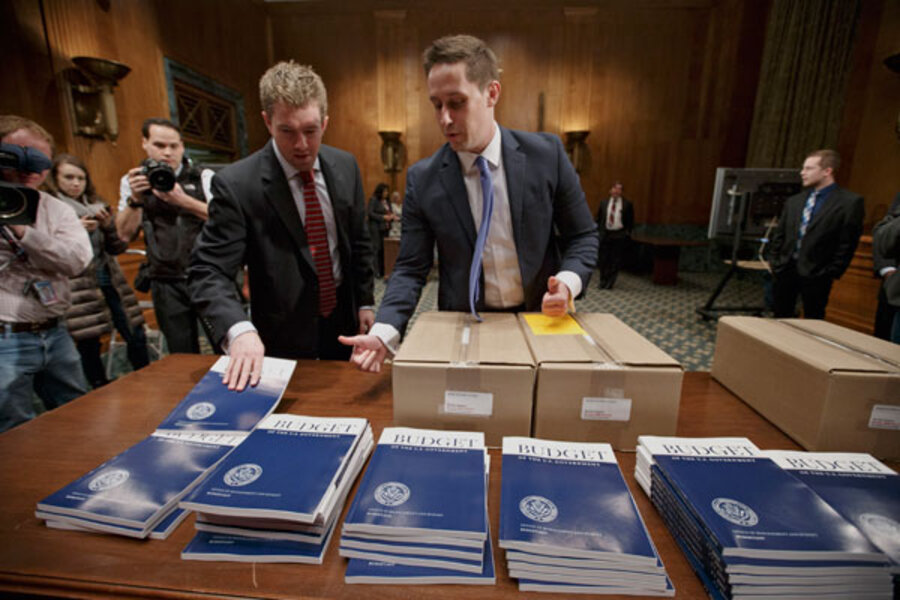Obama budget: 4 things to know
| Washington
President Obama’s proposed budget for 2015 seeks to nudge Congress to spend more money to improve the nation’s roads and rails, more on early childhood education, and more on job skills for adult workers.
To pay for it while also holding down federal deficits, Mr. Obama proposes further tax hikes on high-income Americans – in the form of closing “loopholes” rather than raising tax rates.
From poverty reduction to helping manufacturers improve productivity, the president’s clear priority is to use the government as a lever boost the economic well-being of ordinary Americans. Although the budget also offers proposals aimed at fiscal sustainability, it does little to reduce a public debt load that stands at a historically high level.
The four themes below summarize the budget proposal and Washington’s fiscal state of play.
Taxes would rise (again) on the rich. In an era of chronic deficits, the Obama budget calls for raising new tax revenue by making it harder for high-earning Americans to shield income from taxes. Reducing various deductions and tax breaks, and imposing a “Buffett rule” that ensures millionaires couldn't have below-average tax rates, would raise some $651 billion between 2015 and 2024.
This continues Obama’s track record of asking top earners to bear the brunt of any tax hikes.
Obama also offers an outline for reform of corporate taxes, so businesses could pay a lower tax rate but have fewer deductions. Many economists say this change could create a stronger climate for private-sector job creation.
The White House says its proposals would bring in more than $1 trillion in total tax revenue.
Both sides in Congress share some tax-reform goals but have strong differences on details – with Republicans opposing Obama’s efforts to raise new tax revenue, for one thing.
New spending aims to boost economic growth. Obama’s budget vision is that stepped-up investment in things like roads and manufacturing innovation hubs will buoy economic growth and job creation. So, while starting with Congress’s recent Ryan-Murray framework for spending restraint, he adds some new spending measures.
Highway spending would be paid for partly by changes in the business tax code. Investments in tomorrow’s work force – through early childhood education – would be paid for with higher tobacco taxes.
Behind these plans is the notion that, with annual federal deficits falling closer to historic norms, a focus on rebuilding the economy (rather than on deficit reduction) squares with Americans’ desire for more robust job creation. Many Republicans say the strategy is misguided. House Speaker John Boehner released a statement saying the Obama plan “would hurt our economy and cost jobs” because it would amount to “spending too much, borrowing too much, and taxing too much.”
More help is targeted at low-income families. The budget plan calls for a major expansion of the Earned Income Tax Credit (EITC), which provides an income boost to low-wage households. The change would double benefits for childless workers.
Alongside that, Obama says low-income workers should get a boost in the minimum wage, to $10.10 an hour from $7.25 today.
A hike in the minimum wage has found public support in opinion polls, and some prominent Republicans have embraced the EITC as a program that helps poor Americans while also encouraging them to work.
Deficits come down, but debt stays high. The Obama budget predicts federal debt falling slightly from today’s level above 72 percent of gross domestic product, to about 69 percent of GDP in 2024. That progress comes in part through what some criticize as optimistic assumptions about economic growth, as well as tax and spending provisions.
Jason Furman of the White House Council of Economic Advisers acknowledged that the Obama budget uses a more optimistic forecast than that of the Congressional Budget Office, but he said it’s not far off the CBO or other mainstream forecasts. (The White House calls for growth in the 3 percent range for several years, then slipping to a rate of about 2.3 percent per year.)
The Obama plan envisions significant deficit reduction, too, from proposals whose passage is uncertain: the tax hikes, some new spending controls within Medicare, and immigration reform.
Even if the Obama budget played out as drawn in the spreadsheets, the national debt would remain high by historic standards, potentially crimping economic growth.
“President Obama’s budget unfortunately continues a holding pattern on current federal fiscal policy,” Steve Bell, who tracks fiscal policy for the Bipartisan Policy Center, said in a written analysis of the budget Tuesday.
Mr. Bell praised Obama, however, for seeking to break Washington’s habit of seeking deficit reduction by cutting discretionary programs that invest in economic growth. “Continuing to squeeze these programs, which make up the smallest and slowest growing part of the federal budget, is counterproductive,” he said.






